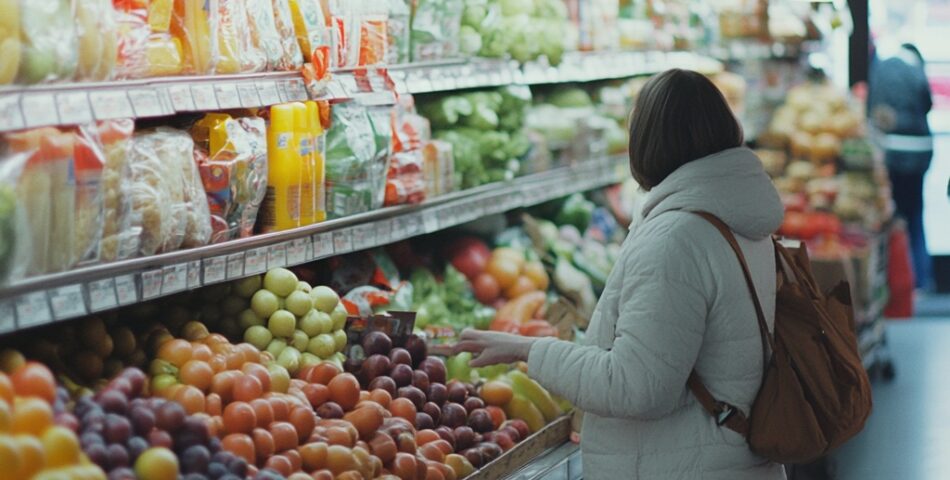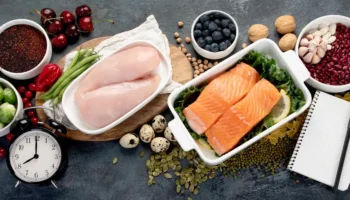As women in midlife, whether you’re navigating the changes of perimenopause, dealing with an empty nest, or planning for your retirement, it’s essential to think strategically about how we spend our money. Every decision—big or small—adds up, and one area that often gets overlooked is our grocery bills. Fortunately, with a few mindful adjustments, you can not only save money on your weekly grocery shopping, but also boost your savings for the future. So let’s explore how you can stretch your budget, reduce waste, and even help secure a comfortable retirement, all while nourishing your body during these transformative years.
How Budget-Friendly Grocery Shopping Benefits You Now and Later
We all know how easy it is to overspend when grocery shopping. Between unexpected cravings and the temptation of convenient, but pricey, pre-packaged foods, it’s easy to go off course. However, adopting a mindful approach to food shopping can be a game changer for your budget—and your health. As we age, particularly around perimenopause, the hormonal shifts may impact our metabolism, energy levels, and even mood. This makes choosing nutritious meals even more important, and planning your meals ahead of time can be a great way to maintain your energy and emotional well-being, all while saving money.
But that’s not all! Smart food shopping isn’t just about getting through the week. It’s also about thinking long-term. If you’ve got kids off to university or are approaching retirement age, each little bit you save now can be put toward your long-term financial goals. So, how can you make grocery shopping work harder for you and your future?
Meal Planning: A Key Strategy for Saving
Planning your meals is the foundation of any successful grocery shopping strategy. If you’ve never given it a try, here’s why you should:
- It Reduces Waste: By planning meals ahead of time, you’re less likely to buy ingredients you won’t use. Plus, you can use leftovers creatively, reducing both food waste and unnecessary spending.
- It Helps You Avoid Impulse Buys: Let’s be honest—how many times have you thrown a snack or random item into your cart, only to regret it later? A shopping list, based on your meal plan, keeps you focused and helps you avoid the temptation to make unnecessary purchases.
- It Saves You Time: When you know what meals you’ll make for the week, you’re in and out of the store more quickly. No wandering around aisles trying to figure out what to buy!
Here are a few tips for effective meal planning:
- Choose simple meals that are easy to prepare and use similar ingredients across multiple dishes.
- Batch cook and freeze leftovers for future use. This is great for both saving time and money, especially if you’ve got a busy lifestyle with work, family, and other commitments.
- Incorporate seasonal produce—it’s cheaper, fresher, and packed with more nutrients.
Smart Shopping Tips for Midlife Women
Now that you’ve got your meal plan, it’s time to hit the store. But before you do, consider these tips to maximize your grocery savings:
- Stick to Your Shopping List: A well-planned shopping list is your best friend. Stick to it, and resist the urge to buy things you didn’t plan for. Not only will you save money, but you’ll also cut down on impulse purchases that can derail your budget.
- Shop When You’re Not Hungry: This is one of the oldest tricks in the book, but it works! Going to the store when you’re hungry is a recipe for disaster. You’ll end up grabbing things you don’t need (hello, chips and cookies!). Instead, try to shop after a meal to help you stay focused.
- Avoid Processed Foods: They’re often loaded with unhealthy fats, sugar, and sodium, and they cost more. Focus on whole foods—fruits, vegetables, lean proteins, and whole grains—which are not only better for your health but also more affordable when you buy in-season.
- Shop for Deals: Check out store promotions, sales, and discounts. Use loyalty cards and apps like Ibotta or Fetch Rewards to earn cashback on your purchases. These tools make it easier to save money while grocery shopping.
- Consider Bulk Purchases: Non-perishable items like pasta, rice, beans, and canned goods are great to buy in bulk, saving you money in the long run. Just be sure to check your pantry to make sure you’re not buying more than you’ll use.
Grocery Savings: Connecting to Your Retirement Fund
As women in midlife, many of us are thinking more about retirement, especially if our kids are now in college or starting their own families. The earlier you can start saving, the better, and your grocery savings could be an unexpected source of retirement funds. Here’s how to make the connection:
- Set Up a Separate Savings Account: Open a separate account specifically for retirement savings, so you don’t mix it with your daily expenses. Every time you save money at the grocery store, transfer a portion of that savings into your retirement account.
- Automate Your Savings: Set up an automatic transfer from your main account into your retirement savings every month. This is a great way to ensure that you’re consistently building your nest egg.
- Use Employer-Sponsored Retirement Plans: If your employer offers a 401(k) or another retirement plan with a matching contribution, make sure you’re contributing at least enough to take full advantage of it. It’s free money that can help grow your retirement fund faster.
- Consider Long-Term Investments: A healthy retirement fund requires smart investments. You can speak to a financial advisor to explore options like IRAs, stocks, bonds, or real estate that align with your retirement goals.
How Meal Planning and Grocery Savings Help You Stay Healthy in Midlife
In addition to boosting your retirement savings, meal planning also helps you maintain a healthy lifestyle. As women enter perimenopause and menopause, our bodies go through significant hormonal changes that can affect everything from metabolism to bone health. Eating a balanced diet rich in whole foods—like leafy greens, lean proteins, and fiber-rich fruits and vegetables—can support hormone balance, reduce the risk of osteoporosis, and help manage symptoms like hot flashes and mood swings.
Here are some nutrient-rich meal ideas that will support your health during perimenopause and beyond:
- Leafy Greens: Foods like kale, spinach, and broccoli are packed with calcium, which is essential for bone health. Pair them with some lean protein like grilled chicken or tofu for a well-rounded meal.
- Flaxseeds and Soy: These are excellent sources of phytoestrogens, plant compounds that can help balance hormones during perimenopause. Add flaxseeds to smoothies or sprinkle them on oatmeal, and try incorporating tofu or tempeh into your meals.
- Omega-3 Fatty Acids: These healthy fats, found in foods like salmon, walnuts, and chia seeds, support brain function and reduce inflammation. They can also help improve heart health, which is particularly important as we age.
- Whole Grains: Foods like brown rice, quinoa, and whole-wheat pasta are high in fiber, which is essential for digestive health. Fiber also helps to stabilize blood sugar levels and improve energy.
Tech Tools for Saving More
Gone are the days of clipping paper coupons. Today, digital tools can help you save money while grocery shopping, making it easier than ever to track discounts, find deals, and manage your budget.
- Price Comparison Apps: Apps like ShopSavvy and Flipp let you compare prices across stores, helping you find the best deals on groceries.
- Coupon Apps: Use apps like Coupons.com and RetailMeNot to find digital coupons you can apply directly to your purchases. It’s an easy way to shave a few dollars off your grocery bill.
- Budget Tracking Apps: Apps like Mint or YNAB (You Need a Budget) can help you keep track of your spending. Set a grocery budget for the month and see how you’re doing as you shop.
Creating a Sustainable Grocery Shopping Routine
The key to long-term savings is creating habits that you can stick with. Sustainable grocery shopping doesn’t just save you money—it helps reduce waste and supports your long-term financial goals. Here’s how you can build a routine that works for you:
- Reusable Bags and Containers: Bring your own bags to the store to avoid paying for plastic bags. Invest in reusable produce bags and containers to reduce plastic waste and help the environment.
- Shop Local: Support local farmers by buying seasonal produce from farmers’ markets. Not only will you get fresh ingredients, but you’ll also be helping local communities and reducing your carbon footprint.
- Cook in Batches: Save time and money by cooking larger portions and freezing individual meals. This will save you from ordering takeout and ensures that you always have a healthy, home-cooked meal on hand.
Conclusion: Smart Grocery Shopping for a Better Future
Smart grocery shopping doesn’t have to be overwhelming—it’s about making a few small, mindful changes that can have a big impact on your financial future and overall health. By planning your meals, sticking to your shopping list, using digital tools, and finding ways to save both now and in the future, you can not only cut down on your grocery bills but also build a stronger retirement fund.
Remember, you’re not just saving money on groceries; you’re investing in a secure financial future. Every little bit adds up, and with a little planning and creativity, you can enjoy delicious, nutritious meals without breaking the bank—while also securing your retirement. Here’s to smarter shopping, a healthier you, and a brighter financial future!







